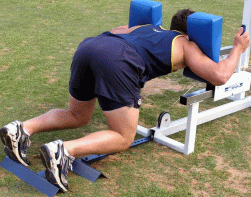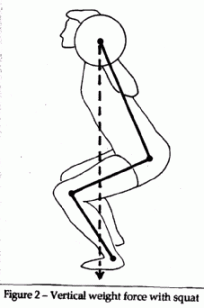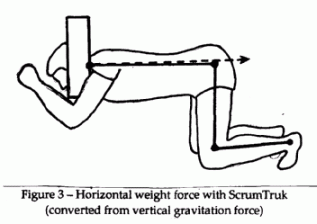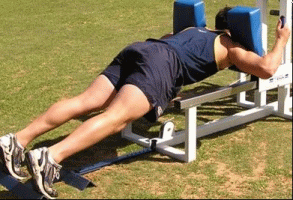The MyoTruk &
conventional strength-increasing
exercises
 
The MyoTruk offers
significant advantages over traditional
exercises typically used to develop leg
strength for rugby. It aids in the
training of specific muscle/joint
actions, rapid adoption of sound
technique, avoidance of lower back
overload and encourages persistence with
the exercise program.
In scrummaging
the typical movement of both hip and knee
joints is from 90° to 120°-130° of
extension (full extension being 180°).
In the past there have been three common
multi-joint exercises used to train hip
and knee extension. These are barbell
squats, barbell dead-lifts and the leg-press.
The barbell squat is often
referred to as the 'king of exercises'
but it is one of the least popular and
most frequently avoided exercises.
At the bottom of the squat movement
there is a large amount of shear force
about the discs of the lower back and
structures of the knee due to the
direction of loading compared to torso
and limb alignment.
With vertical loading on a forward
tilted torso it is difficult to display
good form. Balance problems or lack of
abdominal strength can produce poor
technique and an inability to progress in
the exercise or worse still cause injury.
With barbell dead-lifts this
type of shear force loading is even more
pronounced causing not only accentuated
forward tilting of the torso but also
flexion of the lower lumbar spine which
can cause injury when even moderate loads
are lifted.
 
Due to the inherent
need for exemplary technique to be learnt
before the squat and dead-lift become
viable training movements (which can take
a whole season or longer) the leg-press
is often substituted because of its lack
of risk to the lower back. However, with
the seated leg-press the hip joint range
of movement is only between 40°-90°
extension, which is dysfunctional for the
purpose of training muscle movement for
scrummaging.
Thus traditional gym-based
exercises used for hip/knee extension are
either difficult to learn with harsh
loading patterns for the lower back or
they are not functional for the
all-important hip drive. By contrast the MyoTruk
exercise position is natural and loading
on the lumbar region is mostly straight
line (compressive) without an appreciable
shear component.

This ease of technical mastery and
user-friendly operation encourages
continued use of MyoTruk even during
the playing season when compliance to
other leg exercises, especially
squatting, is traditionally very poor.
The fully extended position
illustrates the unique benefits derived
from exercising with the ScrumTruk. As
the athlete approaches complete
extension, the hip and thigh extensors
are under full loading due to the
increasing resistance provided by the
QuadTorq technology. Note also the very
obvious activation of the gastrocnemius
and soleus muscles of the calf.
|

